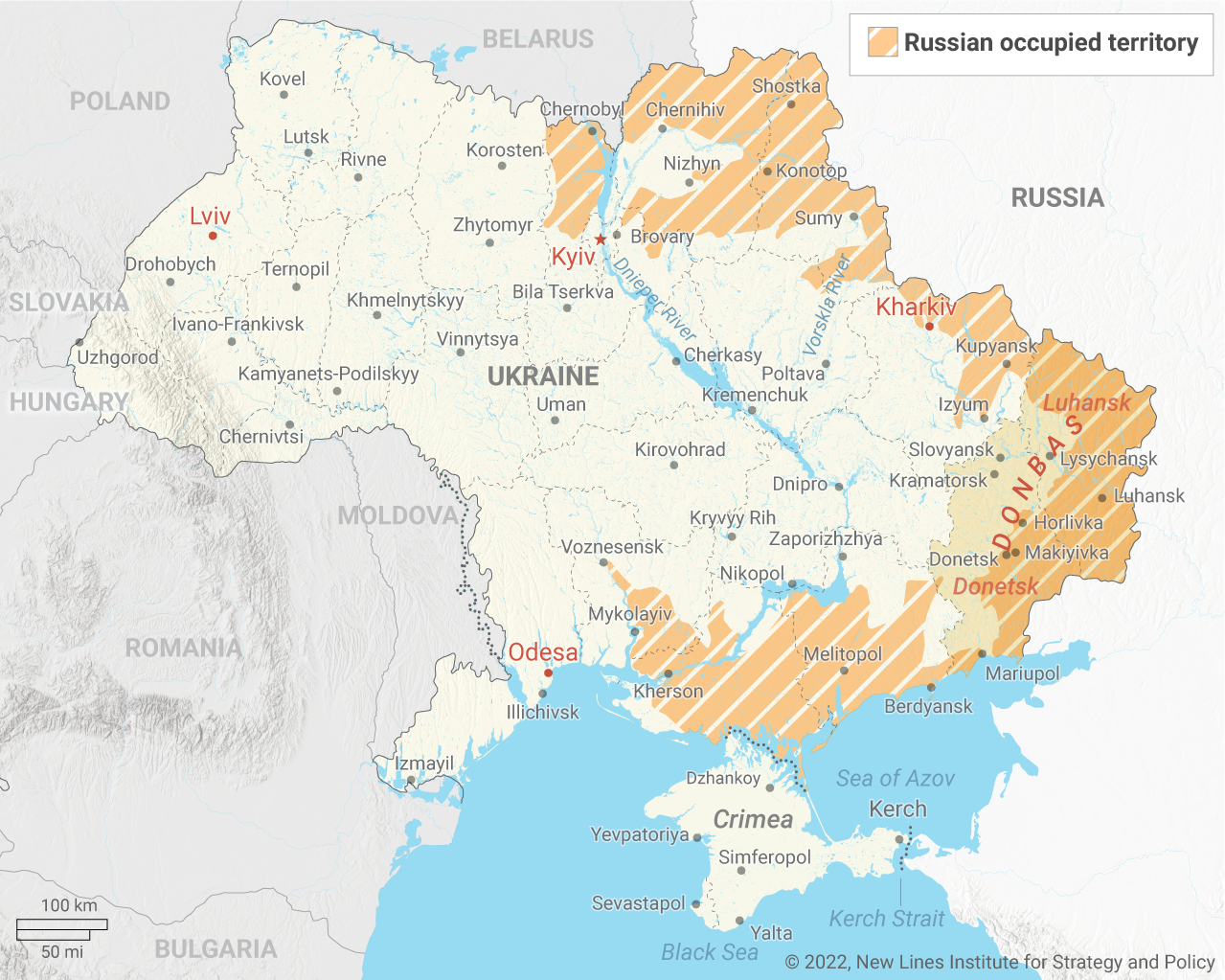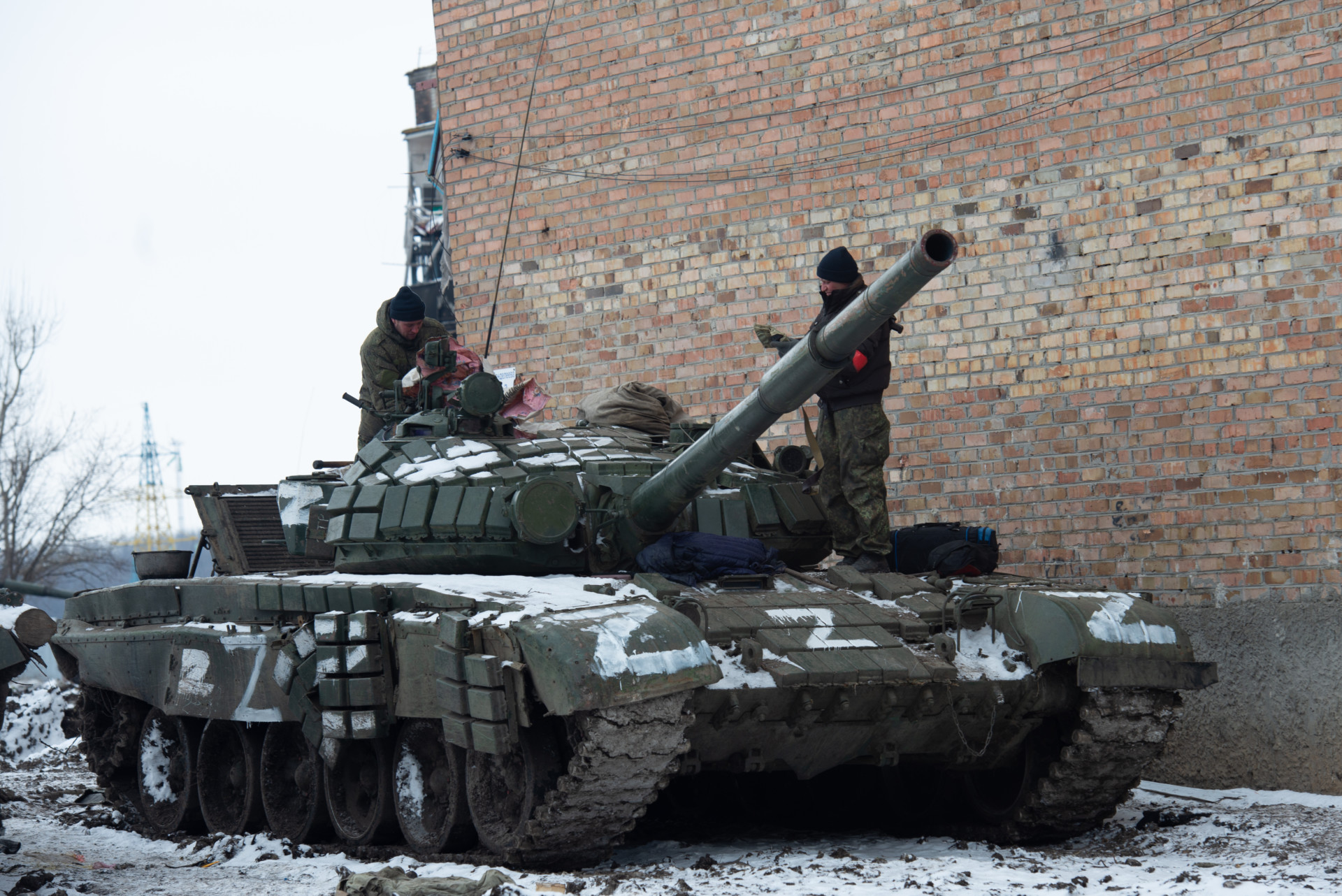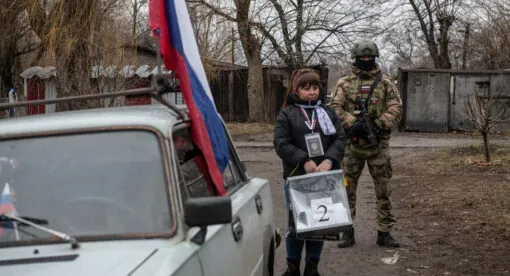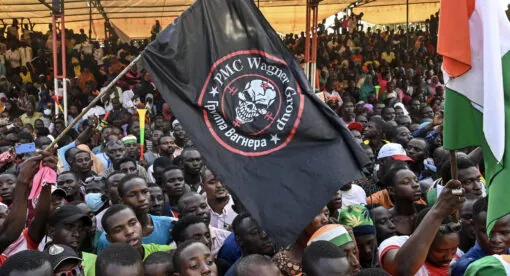The next phase of Russia’s military campaign in Ukraine will be to consolidate Russian and Russian-backed forces’ control over large areas of eastern Ukraine. This is not completely a stabilization phase, as it is occurring during active combat in eastern Ukraine and other areas of the country, nor is it completely a combat phase, as it is occurring in areas of eastern Ukraine that are or may soon be conquered. This hybrid stage is in some regards the most important phase; while the result will depend on outcomes that occur outside the battlespace, this phase will shape the political and diplomatic outcomes after the war. The Russian stabilization and counterinsurgency forces should be watched closely, as the composition of these forces will determine the degree to which Russia can maintain long-term control over eastern Ukraine.
Russian President Vladimir Putin’s strategic goals in invading Ukraine will have profound consequences for the future of European security. In his Feb. 24 announcement of the invasion, Putin said Russia was seeking to “denazify” and “demilitarize” Ukraine, with subordinate goals of protecting the Russian-backed, breakaway Luhansk People’s Republic and Donetsk People’s Republic from what he said was an imminent Ukrainian military campaign. These goals were articulated after Putin recognized Luhansk and Donetsk as independent and authorized the deployment of Russian forces to the regions.
Subsequent Russian state-backed information operations, which are especially focused on shaping the opinion of the Russian people, have emphasized this as a military campaign to defend Luhansk and Donetsk from “abuse and genocide” and further to defend Russia from alleged U.S. weapons of mass destruction facilities in Ukraine. As Russian forces attempt to consolidate territory on both sides of the Dnieper River and maintain a stronghold in eastern Ukraine, a strategy to fragment Ukraine into a multi-entity frozen conflict is emerging. Russian forces will seek to create conditions in western Ukraine that deny long-term stability, human security, and strong relations with NATO and the European Union, while seeking to maintain fragile control over eastern Ukraine through counterinsurgency and stabilization missions.
A Russian Vision for the End State in Ukraine?
As Russia’s military campaign has unfolded in Ukraine, Putin’s overarching goals have begun to take form on the battlefield. Russia is waging this campaign to weaken or destroy a Western-leaning government in Kyiv and could leave in the wake of its campaign a fragmented Ukraine with an isolated, landlocked, and financially strained “West Ukraine.” To this end, the Russian forces are generally following the most dangerous course of action that New Lines experts identified in January: Russian forces occupying eastern Ukraine up to the Dnieper River and besieging Kyiv. However, certain features of Russia’s campaign in Ukraine show that Russian decision-makers believe the outcome will differ from the one New Lines anticipated.
The outcome the Russians see involves creating multiple political entities within Ukraine. These could include an expanded Donetsk and Luhansk that would result in Russian-backed Ukrainian control over the entirety of those two regions, as well as Russian-backed entities for Kyiv, Kharkov, and other areas in central-eastern Ukraine and an independent, Western-backed West Ukraine (with a likely capital in Lviv and including areas west of the Dnieper) that might incorporate Ukraine’s Black Sea coastline, including the strategic port of Odesa.
From the Russian perspective, a potential West Ukraine would need to be severely weakened both economically and militarily. To achieve this goal, Russia would likely target civil and military infrastructure and agriculture in West Ukraine to damage it so much that the cost of supporting and rehabilitating West Ukraine and preparing it for Ukrainian refugees to return would be prohibitively expensive. Dividing Ukraine in this way would provide Russia with multiple buffers between NATO countries such as Poland and Romania and the pre-war Russian border with Ukraine, leaving the EU and NATO to assist and rebuild a devastated West Ukraine.
The Russians have introduced a large and diverse force presence around Kyiv that suggests at a minimum an extended period of pressure on the city, from multiple sides, that would likely place it under a type of siege. It is also possible that Ukrainian President Volodymyr Zelenskyy and his government would not be allowed to remain in Kyiv at the end of the war, whether the city is formally captured by Russian forces or a brokered agreement ends the Russian campaign against it. The region around Kyiv also could become a special administrative region belonging to a transitional Ukrainian authority.
Perhaps counterintuitively, of all the potential outcomes of the fighting, the future status of Odesa is the most unclear. Putin and decision-makers who agree with him view Odesa as a natural part of “Novorossiya” that extends from the Black Sea around Odesa and up through Kharkiv.
In the area of Odesa, the Russian forces will require a complicated, coordinated sea and ground invasion that will be challenging to carry out with the current Russian force presence and disposition. It is also in the interest of the Ukrainian government and its allies to create a sea link to the outside world and a NATO-backed beachhead on the northern shore of the Black Sea located beyond NATO territory. Russia would want to seize this beachhead, provide strategic depth for Crimea (which makes holding the city of Kherson on the Dnieper River so important), and turn a potential West Ukraine into a landlocked entity dependent on NATO’s strategic rear for a sea outlet.
Whether Odesa remains Ukrainian or not will strongly affect Russia’s consolidation stage in eastern Ukraine. To hold Odesa, Russian forces would need to advance and occupy both the remaining western areas of Ukraine’s Black Sea coast and a significant and defensible bubble to the north of the city. This line of advance would require the application of significant air, armor, artillery, and infantry assets and would likely be too resource-intensive and expensive for Russia to maintain indefinitely. Bursting this bubble would be a constant focus of West Ukrainian forces, which would likely necessitate a permanent Russian garrison in an “Odesa Oblast” and potentially a Russian military infrastructure investment in Odesa that would turn the city into both an armed camp and a major Russian naval and air installation on par with the Tartus and Hmeimim bases in Syria. Odesa would be both an expeditionary and a domestic deployment for Russian forces, with long-term geopolitical consequences on par with the Russian enclave at Kaliningrad.
Russia’s Strategy in Eastern Ukraine
Russia’s approach in Ukraine, especially eastern Ukraine, indicates that the outcome Russian decision-makers are seeing includes buffer entities as a key feature. The U.S. and its NATO allies have been telegraphing the strategy to counter Russia in Ukraine for many months: a strategy of insurgency and sanctions. Russian decision-makers, for all the attention on the failed Russian attempt at a decapitation operation to seize Kyiv early in the war, have generally adapted Russia’s military campaign conform to a “boa constrictor” approach: seizing terrain steadily and slowly in eastern Ukraine, squeezing Ukrainian resistance in conquered areas of the region.
Further, Russian, and Russian-backed forces are demonstrating a determination to achieve, at a minimum, complete Russian control over Ukraine’s Sea of Azov coastline, which Moscow seems to believe is achievable and desirable, despite the cost in resources and lives. Achieving this goal would allow Russia to create a land bridge from the Crimean Peninsula to Donetsk and secure potable water sources for Crimea from southern Ukraine in perpetuity. These Russian advances are also seizing agricultural and electricity-generating resources that could be used to support the future care and rehabilitation of Russian-backed areas of eastern Ukraine.

These areas, especially urban areas, are being depopulated through sieges and Russian-backed “humanitarian corridors” that often lead either to Russia or Russia’s proxy, Belarus. As in eastern Syria, Russia is trying to determine who “votes with their feet” by fleeing to Ukrainian government-held areas or deeper into Europe, and who could be reconcilable to a Russian-backed order in Ukraine and are electing to flee the fighting to Russia, Belarus, and Russian-backed areas of Ukraine. A depopulated eastern Ukraine that is welded to Russia and Belarus would likely be easier to stabilize and support over the long term. In eastern Ukraine, Russian decision-makers might copy the strategy Syrian President Bashar al-Assad used to depopulate and change the demographics of regime-held areas of Syria, to make these areas more easily controllable – a strategy that Russia facilitated.
What Might a Russian Counterinsurgency Position Look Like?
Ukrainian and pro-Ukrainian forces positioned to conduct a long-running insurgency throughout the country are likely to put up a strong resistance to Russia’s efforts. For several years, the Ukrainian military has worked with the United States and other NATO countries to prepare to conduct an insurgency against a Russian invasion and occupation of Ukrainian territory beyond the Donbas region. The planning for this Ukrainian insurgency has included support from U.S. and NATO intelligence agencies and would use a blend of Ukrainian regular and special forces, territorial defense units, and local anti-Russian militias. These Ukrainian insurgent forces could also include thousands of foreign fighters. Neighboring NATO countries would likely provide a Ukrainian insurgency with lethal and non-lethal support, and U.S. and NATO countries would likely share intelligence with Ukrainian insurgent forces.
Russian forces have met competent and fierce resistance from Ukrainian and pro-Ukrainian forces, but the Russians are steadily consolidating defensible terrain east of the Dnieper and in the region around Kyiv. However, Russia is conducting a parallel diplomatic strategy to its military campaign, and the Russian-Ukrainian talks might lead to an off-ramp from the conflict. This means that Russia is also preparing to try to avoid a difficult and protracted counterinsurgency in Ukraine by weakening pro-Western Ukrainian forces, to Russian satisfaction, through a diplomatic settlement.
Russia seems intent to achieve a position of strength so that its counterinsurgency efforts are as effective as possible after the war. This means that Russian and Russian-backed forces are making slower advances in eastern Ukraine but are making these advances in a way that will meet and overcome resistance, displacing potential military and political adversaries and giving Russian and pro-Russian Ukrainian intelligence and counterinsurgency forces time to establish networks of coercion on the ground. That this is occurring while Ukrainian forces and allies are focused on the defense of Kiev, Kharkiv, and Odesa, and the areas in western Ukraine is a potential advantage to these intelligence services and forces because the current situation could significantly weaken Ukraine and allied insurgency efforts in eastern Ukraine.
Consolidating Russian control over these buffer entities inside Ukraine will require a basket of forces that will emerge over the coming weeks and months. From Moscow’s perspective, the Ukrainian forces (formal military, territorial defense, and local irregulars) present in eastern Ukraine will have to be identified, destroyed, and displaced. Ukrainian conventional forces melting into the Donbas region is a long-term challenge for Russia and Russian-backed forces in eastern Ukraine. Russian decision-makers will likely seek to avoid this.
Even achieving that difficult goal is not enough. The security forces of the Donetsk People’s Republic and the Luhansk People’s Republic are not numerous enough to secure the entirety of an expanded Donbas region, so these breakaway entities are highly unlikely to be able to administer all of Russian-occupied eastern Ukraine. Russian conventional forces would be required to establish a long-term and expensive defensible perimeter at the “borders” of eastern and western Ukraine. Maintaining control of Kyiv alone would be challenging. Russia might also seek to gain international buy-in for a pro-Russian governing authority in Kyiv by implementing some type of international force to oversee the Ukrainian capital. This force could incorporate the Collective Security Treaty Organization, another country that has good ties with both China and Russia, or perhaps even a traditionally neutral country.
Throughout eastern Ukraine, Russia would likely adapt lessons from Chechnya and Syria, with a counterinsurgency position to include Russian military police; Spetsnaz; Federal Security Service direct action; national guard units such as Chechen and other regional forces; private military companies; and foreign fighters from Africa, Latin America, the Middle East, and Southeast Asia trained in counterinsurgency by Russia. This collection of forces could reduce the risk to any one Russian force, would alleviate pressure on Russian-backed Ukrainian forces, and would place eastern Ukraine into a model of consolidation that Russia has managed at a strategic level in Chechnya and Syria.
Russia’s unfolding military campaign in Ukraine is having significant human consequences, and the scenario of an indefinite Russian counterinsurgency position in Ukraine could have grave second- and third-order effects. The Russian boa constrictor approach in Ukraine could drive instability and displacement and weaken the economic, social, and political fabric of the EU, potentially leading to an endemic state of conflict in Europe for years. Millions more Ukrainians would likely be displaced, thousands or tens of thousands more Ukrainian civilians could be killed (on both sides of the conflict), tens of thousands more Ukrainian and Russian soldiers and fighters could be killed and wounded, and extensive destruction to Ukrainian infrastructure is likely. Moreover, the war in Ukraine has led to massive U.S.-led international sanctions against Russia that could smother the Russian economy for decades, which would have grave consequences for human development in Russia. These effects could metastasize regionally, with a long-term displaced population in Europe, a potential spread of the conflict to NATO countries, and a long-standing challenge to the international rules-based order.
Nicholas A. Heras is the Deputy Director of the Human Security unit at New Lines. Prior to the New Lines, he was the Director of Government Relations and the Middle East Security Program Manager at the Institute for the Study of War (ISW). Nicholas has authored or co-authored numerous reports and analytical articles on topics concerning Global and Middle East security issues, presented widely on these topics to multiple U.S. government and military agencies, and non-government organizations. He has been a frequent commentator to the media on Global and Middle East security issues. He tweets at @NicholasAHeras.
Caroline Rose is a Senior Analyst and Head of the Strategic Vacuums program in the Human Security unit at New Lines. Her commentary and work on geopolitics and Middle Eastern affairs have been featured in Foreign Policy, The Independent, Alhurra, Limes Magazine, and the Atlantic Council’s MENASource. She tweets at @CarolineRose8.
Eugene Chausovsky is Senior Analyst and Program Head, Training and Analytical Products. Previously, he served as Senior Eurasia Analyst at Stratfor for 10 years. His work focuses on political, economic, and security issues pertaining to the former Soviet Union, Europe, and Latin America. He tweets at @EugeneChausovsk.
The views expressed in this article are those of the authors and not an official policy or position of the New Lines Institute.








